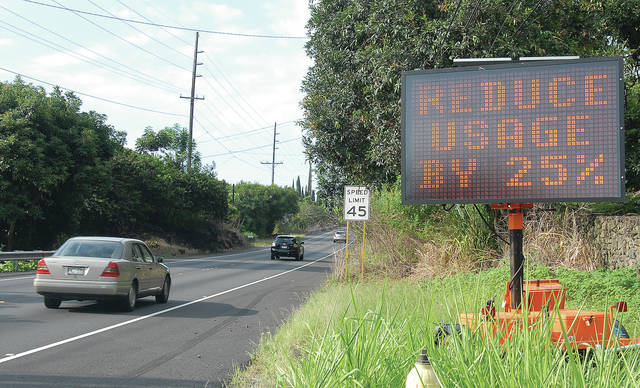KAILUA-KONA — For at least a couple of days in mid-October and during the thick of the Ironman World Championship, Hawaii County was down five of its 13 deep wells in North Kona.
Yet only a select few people knew it.
On Oct. 3, the Department of Water Supply sent out a press release notifying the public that the Hualalai and Palani deep well sites had been returned to operational status, leaving only three deep wells inoperative.
The repairs allowed DWS to downgrade the North Kona water restriction, which has existed in some form or another since the start of the year.
For roughly two months prior, the department mandated customers halt nearly all irrigation and the limit water usage to basic necessities only. With the return of two wells to service in early October, the restriction was dialed back to a mandatory 25 percent reduction.
The department’s rollback of the restriction eased some of the public concern about what strain the tens of thousands of visitors in town for Ironman might add to the beleaguered water system.
On Tuesday at 4 p.m., a few hours after a telephone inquiry to DWS from West Hawaii Today, the department sent out another press release — its first in four weeks.
This time, DWS noted that the Hualalai deep well site has been inoperative since the first week of October, meaning it failed only a few days after it was brought back online.
The department also included in the release information that the Keahuolu deep well was out of commission the following week — the week of Ironman.
The third pertinent portion of the department’s public communication Tuesday was that the deep well at Honokohau was repaired and operational as of “mid-October.”
DWS said in the release that a 25 percent mandatory water restriction remains in effect as four of North Kona’s 13 deep wells remain out of service.
Keith Okamoto, DWS manager-chief engineer, verified that North Kona was without five wells for at least a couple of days during the middle of October, though he couldn’t provide specific dates because he was contacted outside his office.
He also verified the four-week gap between public notifications despite two wells dropping out of service and one coming back online during that time period. He explained the department’s reasoning behind its silence Tuesday afternoon.
“We knew that Honokohau was coming on at any time, so we didn’t feel the need to go back into an emergency restriction mode for a few days,” Okamoto said. “That wouldn’t make any sense.”
“We were trying to do the prudent thing without causing undue or unnecessary alarm or concern,” he continued. “We were very comfortable with our tank levels throughout.”
Okamoto added that topside testing, which he said is done to make sure any deep well malfunction is truly connected to the pump and/or motor before they are excavated, takes some time.
He said the timing of that testing factored into the department’s decision to forgo immediate public disclosure of the deep well failures, despite those failures coinciding with Ironman.
The particular issues at Hualalai and Keahuolu point to the same problems that have plagued the North Kona system throughout the water crisis — premature failures of relatively new equipment.
Okamoto explained Hualalai’s most recent repair included a spare motor intended for a separate deep well and a pump purchased specifically for that site. DWS confirmed a blown motor was the cause of Hualalai’s failure. The faulty equipment has since been extracted.
Keahuolu was repaired in January with fresh parts and again during the summer, also with new equipment, Okamoto said. The department is still conducting topside testing at the site and Okamoto could not offer a definitive answer Tuesday afternoon as to what specifically caused the well’s failure.
Okamoto stressed that despite ongoing problems, the public should not be overly concerned. He also said the water restriction will not exceed the 25 percent mandatory cutback now in effect unless more wells go out of commission.
“We’re comfortable right now, so I think that’s the message that we want to convey,” he said. “With Honokohau back online (and) Palani back online, although we still have four wells out of service, we’re very comfortable with the amount of water we’re producing and tank levels have remained good.”
Deep wells at Waiaha and Keopu, along with those at Hualalai and Keahuolu, round out the four inoperative sites in North Kona.
New well equipment plummeted to the bottom of the Waiaha deep well several months ago and has yet to be removed. There is no timeline for its return to service nor for the return of Hualalai or Keahuolu.
Okamoto said Keopu is scheduled to come back online at some point in the middle or latter part of December, at which point he is optimistic the 25 percent mandatory water restriction will be rolled back to a 10 percent voluntary conservation.
Email Max Dible at mdible@westhawaiitoday.com.







